A short animation by Goo-Shun Wang.
Oddities
Piggyback

Between Grana and Casorzo, Italy, grows a cherry tree atop a mulberry tree.
It’s not uncommon for a small tree to grow on a larger one, but it’s rare for them to reach such a large size. The cherry even flowers in the spring.
The pair are known as the Bialbero de Casorzo, or “double tree of Casorzo.”
Last Words
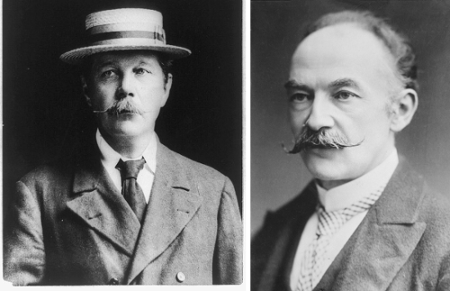
A letter from Arthur Conan Doyle to Light, April 5, 1930:
SIR, — It might interest your readers to know that some weeks ago I had a communication which professed to come from Thomas Hardy. It came through an amateur Medium from whom I had only once before had a message, which was most veridical. Therefore, I was inclined to take Hardy’s message seriously, the more so as intrinsically it was worthy of him. I should place it on the same level of internal evidence as the Oscar Wilde and the Jack London scripts. Hardy gave a posthumous review of his own work, some aspects of which he now desired to revise and modify. The level of his criticism was a very high and just one. He then, as a sign of identity, sent a poem, which seems to me to be a remarkable one. It describes evening in a Dorsetshire village. Without quoting it all I will give here the second verse which runs thus:
Full well we know the shadow o’er the green,
When Westering sun reclines behind the trees,
The little hours of evening, when the scene
Is faintly fashioned, fading by degrees.The third and fourth lines are in my opinion exquisite. I do not know if they were memories of something written in life. I should be glad to know if anyone recognises them.
Arthur Conan Doyle
Podcast Episode 79: One Square Inch of the Yukon
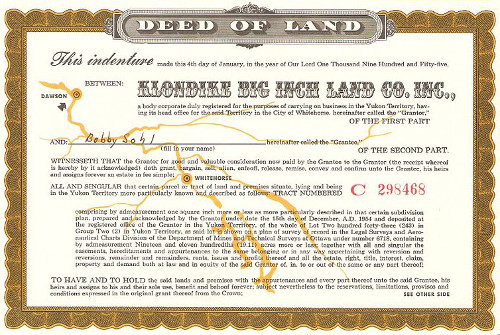
If you opened a box of Quaker Oats in 1955, you’d find a deed to one square inch of land in northwestern Canada. In this week’s episode of the Futility Closet podcast we’ll tell the story behind the Klondike Big Inch land giveaway, whose bizarre consequences are still being felt today.
We’ll also hear about a time traveler who visited the British Museum in 1997 and puzzle over why a prizewinning farmer gives away his best seed to his competitors.
Told You So
New Yorker Kam Brock was sedated and placed in a mental hospital last September because police thought she might be delusional — for one thing, she insisted that Barack Obama was one of her Twitter followers. The hospital set this as an objective for her release: “Patient will verbalize the importance of education for employment and will state that Obama is not following her on Twitter.”
It turns out that @BarackObama does follow Brock on Twitter — but the account doesn’t belong to the president; it was leased to a nonprofit by his campaign.
In 1980, 25-year-old Alfred Lawrence Patterson was admitted to Michigan’s Northville Regional Psychiatric Hospital. He said that the Secret Service and Sen. Edward Kennedy had conspired to place him there.
In fact Patterson had been interviewed by the Secret Service after he’d sent a threatening letter to Kennedy; they concluded that he needed psychiatric care. (Impressively, Patterson won that year’s House primary from within the hospital, drawing 50 percent of the vote.)
When Martha Mitchell, the wife of Nixon attorney general John Mitchell, began to claim that the White House was engaged in illegal activities, she was rumored to be mentally ill. But events proved her right. Nixon later told David Frost, “If it hadn’t been for Martha Mitchell, there’d have been no Watergate.”
Psychologists remember this as the “Martha Mitchell effect” — when a client insists that she’s being chased by the mob, or that the police have been spying on her, she’s not necessarily delusional. In the words of psychotherapist Joseph Berke, “even paranoids have enemies.”
(Thanks, Jason.)
Absent Fiends
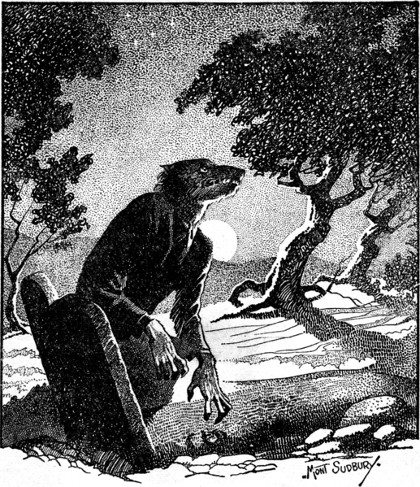
The nonexistence of horrific creatures is, so to speak, not only a fact, but it would also appear to be a fact that is readily available to and acknowledged by the consumers of horrific fictions. However, audiences do appear to be frightened by horror fictions; indeed, they would seem to seek out such fictions, at least in part, either in order to be frightened by them or with the knowledge and assent that they are likely to be frightened by them. But how can one be frightened by what one knows does not exist?
— Noël Carroll, The Philosophy of Horror, 1990
Amphibious Assault
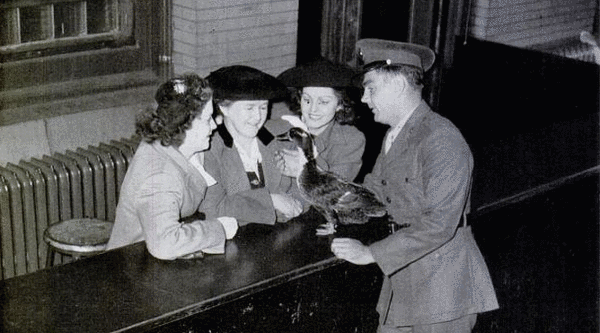
The U.S. 2nd Marine Division picked up an unlikely member in 1943: Siwash the duck, won in a New Zealand raffle, spent 18 months as the mascot of the 1st Battalion, 10th Marines. He took part in three major engagements: Tarawa, Saipan, and Tinian, even winning a combat citation for duckly valor:
For courageous action and wounds received on Tarawa, in the Gilbert Islands, November 1943. With utter disregard for his own personal safety, Siwash, upon reaching the beach, without hesitation engaged the enemy in fierce combat, namely, one rooster of Japanese ancestry, and though wounded on the head by repeated pecks, he soon routed the opposition. He refused medical aid until all wounded members of his section had been care of.
“Siwash holds the rank of sergeant and has a thirst for beer,” reported the Associated Press the following year. “The duck nearly lost its tail feathers on a pier at Tarawa, but since then it learned to jump in a foxhole the minute the marines leaped.”
When his division arrived in Chicago in October 1944, a luncheon party was held in Siwash’s honor, and he gave two radio broadcasts. After the war he helped in recruiting for the Korean War before retiring to the Lincoln Park Zoo, where he died in 1954, 11 years after signing up, modest to the end.
Take Two
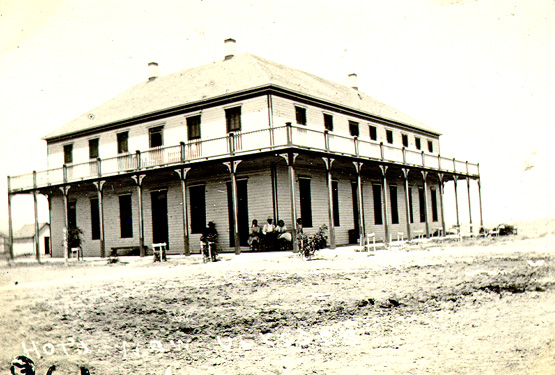
Ulysses, Kansas, moved. Founded in 1885, the town thrived at first, but after four years a drought arrived, and by 1906 the population had dwindled from 1500 to 100. Worse, during the boom years the town had sold thousands of dollars’ worth of bonds to finance improvements that were never made. When East Coast bondholders began to sue, the city fathers were forced to raise the taxes of the remaining residents in order to meet the judgments.
After a year of this, in February 1909, the people of Ulysses decided as a body to give up and start over. They cut their builings into sections, moved them two miles west on horse-drawn sledges, and established “New Ulysses.” The lots on the old site were deeded back to the bondholders, and the new town became the county seat in June.
The Hotel Edwards, above, is the only remaining business building from “Old Ulysses.” It rests today on the grounds of the Grant County Museum.
A Late Plea
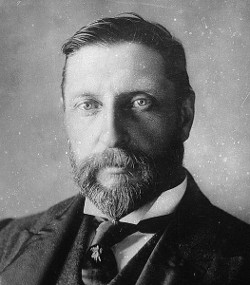
On July 21, 1904, the London Times published a curious letter from H. Rider Haggard. On the night of Saturday, July 9, he said, he had gone to bed at about 12:30 “and suffered from what I took to be a nightmare”:
I dreamed that a black retriever dog, a most amiable and intelligent beast named Bob, which was the property of my eldest daughter, was lying on its side among brushwood, or rough growth of some sort, by water. In my vision the dog was trying to speak to me in words, and, failing, transmitted to my mind in an undefined fashion the knowledge that it was dying. Then everything vanished, and I woke to hear my wife asking me why on earth I was making those horrible and weird noises. I replied that I had had a nightmare about a fearful struggle, and that I had dreamed that old Bob was in a dreadful way, and was trying to talk to me and to tell me about it.
The following morning Haggard and his wife told the story to their daughters, and it was not until that evening that the family realized that Bob was missing. Haggard began to investigate, and on Thursday morning he and a groom discovered the dog’s body floating in the River Waveney about a mile and a quarter from the author’s home. Haggard was also approached by two railway plate-layers who on Monday had found the dog’s collar atop a bridge that crossed the water between Ditchingham and Bungay. “It would seem that the animal must have been killed by an excursion train that left Ditchingham at 10.25 on Saturday night, returning empty from Harlestone a little after 11.” This was the last train that ran that night, and no trains ran on Sunday.
It appeared that the train had knocked the dog into the reedy margin of the water, where, if it was still alive, “it must have suffocated and sunk, undergoing, I imagine, much the same sensations as I did in my dream, and in very similar surroundings to those that I saw therein — namely, amongst a scrubby growth at the edge of water.”
I am forced to conclude that the dog Bob, between whom and myself there existed a mutual attachment, either at the moment of his death, if his existence can conceivably have been prolonged till after one in the morning, or, as seems more probable, about three hours after that event, did succeed in calling my attention to its actual or recent plight by placing whatever portion of my being is capable of receiving such impulses when enchained by sleep, into its own terrible position.
The full letter is here. Haggard added a certificate by a veterinary surgeon, affirming that Bob must have been in the water three days; from his wife and children, confirming his description of the nightmare on Sunday morning; from the plate-layer who discovered the collar; and from the groom who had found the dog with him. Draw your own conclusions.
Child of Fortune

You exist because of a fragile string of circumstances: Your parents had to meet and procreate at a particular time, and so did their parents, and so on. If any of these things had not happened, you would not be here.
But the past that produced you also produced a whole series of historical and natural calamities — the Holocaust, World War I, and slavery, for example. Very likely those calamities influenced the delicate causal chain that leads to your existence. Without them, your ancestors would not have met and had children when they did. Properly speaking, then, shouldn’t you regret your own existence, since it required these tragedies to bring it about?
University of Haifa philosopher Saul Smilansky writes: “A ‘package deal’ is involved here: those events, together with oneself; or, the absence of the historical calamity, and the absence of oneself. So, all considered, ought one to prefer never to have existed, and to regret that one exists?”
(Saul Smilansky, “Morally, Should We Prefer Never to Have Existed?”, Australasian Journal of Philosophy 91:4, 655-666.)
